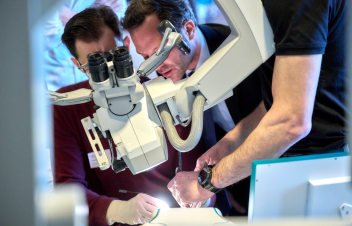Learning Cervical Myelopathy Treatment Techniques
- surgeonslab1
- Aug 1, 2024
- 4 min read
Cervical myelopathy is a major medical condition. It affects an enormous percentage of lives globally. The problem stems from spinal cord compression. This interferes with the signals from the nerves and leads to many different kinds of difficulties. Failure to handle it may have grave consequences, which include lifelong injury or paralysis. This article will look at therapies for cervical myelopathy, mainly cervical spondylotic myelopathy treatment. The goal of this piece is to give practical help to those who are affected by this health condition.
Understanding Cervical Myelopathy
Cervical myelopathy is a significant medical disorder affecting the spinal cord in the neck. This region includes essential nerves which allow our bodies to function correctly. Sometimes, the spinal cord becomes squeezed or ruined. This can take place for many different reasons, including a burst disk, age-related alteration of the back, or an injury acquired in a vehicle collision or sports. When the vertebrae shift, they could come up against the nerve root, preventing the signals from being exchanged between the brain and the rest of the body. Recognizing these difficulties early on and requesting help is essential in restoring well-being.
Cervical myelopathy causes problems with the bladder, bowels, and limbs, including numbness and paralysis. Ignoring something might bring about permanent harm, paralysis, and occasionally even fatalities.
This compression can be caused by a variety of factors, including:
Herniated discs
Bone spurs
Spinal stenosis
Trauma
Tumors
The symptoms of cervical myelopathy can vary depending on the severity of the condition. Common symptoms include:
Neck pain
Arm pain
Weakness or numbness in the arms or legs
Difficulty walking
Loss of bladder or bowel control
Cervical Spondylotic Myelopathy Treatment
Cervical spondylotic myelopathy is a degenerative disorder. It is an indication of considerable spinal wear and exertion. This causes harm to the spinal cord. This prevalent ailment affects millions all throughout the world. It results in symptoms ranging from tiny numbness in the hands and feet to total paralysis in severe instances. The therapy for cervical spondylotic myelopathy hinges on its severity. It typically falls into three stages: mild, moderate, and severe.
Mild-stage individuals may have weakness or tingling in their limbs. They stay perfectly mobile. Physical therapy, medication, and changes to lifestyles are common choices for treatment. These seek to relieve symptoms and postpone disease development. In mild circumstances, symptoms escalate. They include weak muscles, lack of integration, and bowel or bladder problems. In certain cases, surgery can be necessary to lower pressure on the vertebrae and support the spine.
Severe symptoms could result in total immobilization and loss of bodily functions. They may severely interfere with everyday operations. In such cases, emergency surgery may be needed. It can prevent more damage while also preserving some independence and function. We must understand the significant nature of cervical spondylotic myelopathy. This is critical for deciding the best path for treatment. Early diagnosis is vital. It may prevent long-term harm while bettering patient outcomes.
Conservative Treatment
Conservative treatment is usually the first line of treatment for cervical spondylotic myelopathy. This includes:
Physical therapy to improve range of motion and strength
Pain management with medication
Lifestyle changes, such as quitting smoking and losing weight
Surgical Treatment
Surgical intervention is typically advocated for individuals exhibiting severe cervical spondylotic myelopathy. Surgery aims to relieve pressure on the spinal cord. This should improve symptoms. The following surgical procedures are commonly employed:
Discectomy: removing the herniated disc
Spinal fusion: fusing the vertebrae together to stabilize the spine
Laminectomy: removing part of the vertebrae to relieve compression
Simulation Training for Neurosurgeons
Neurosurgical simulator guidance is vital in neurosurgical education. It lets neurosurgeons practice their skills without risking patient safety. This training is especially valuable in neurosurgery. The margin for error is tiny, and mistakes can have catastrophic effects. Simulation training uses real-life scenarios to train neurosurgeons. It helps them master their skills. It also fine-tunes their techniques for complex dissections and suturing.
A surgeon can rehearse a complex aneurysm clipping procedure. This will refine their hand-eye coordination and precision. It will help minimize bleeding and prevent complications. Also, a clinical evidence neurosurgical simulator for training helps neurosurgeons handle unexpected issues, like bleeding or swelling, in a controlled setting. This improves their crisis management skills. Simulation training can greatly improve neurosurgeons' skills. This leads to better patient outcomes and lower morbidity rates.
SurgTrain, a platform from SurgeonsLab, simulates neurosurgery. It offers a complete training environment. This platform includes educational modules, real-time feedback mechanisms, and intuitive interfaces.
Key Takeaway
Cervical myelopathy is a major medical disorder that calls for quick and efficient intervention. The course of treatment of cervical spondylotic myelopathy is determined by its severity. It can involve both conservative and surgical procedures. To ensure the best possible results, choose a skilled and reputable neurosurgeon who uses cutting-edge techniques and software supported by best neurosurgeon with customer stories. Simulation training, such as SurgTrain, is an essential component of spinal surgery education.
Knowing the origins, symptoms, and treatments for cervical myelopathy helps patients to make more educated choices about their health.







